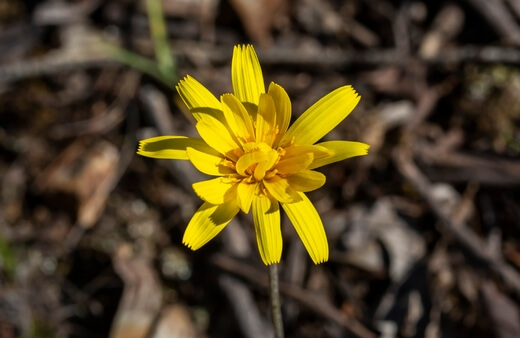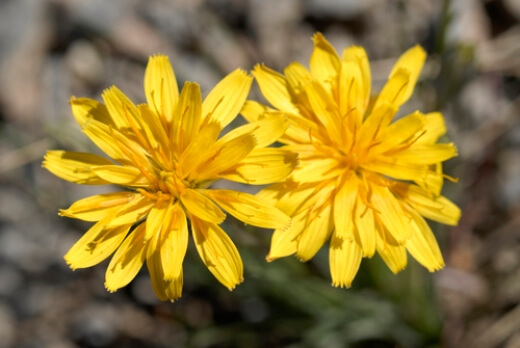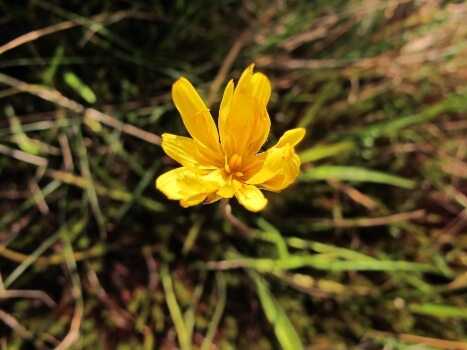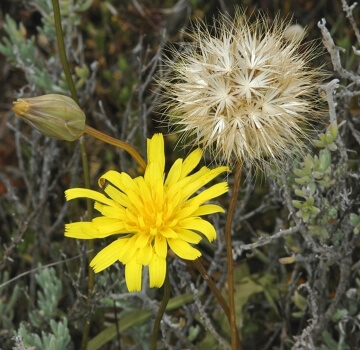Murnong or yam daisy forms a part of the Microseris genus which has long been considered one of the most important Australian bush foods, being cultivated for centuries as bush tuckers. The tuberous rootstocks were a staple part of the Aboriginal people’s diet for generations.
These native perennial herbs feature tufted rosettes of flat-toothed green leaves that form below daisy or dandelion-like bright yellow blooms on gently arching stems. Today, these plants are a popular choice for gardens as they can be grown easily, provide lovely pops of colour in yards and offer essential bush food to growers at home.
Let’s take a detailed look at how you can grow and care for these delightfully dainty and decorative native herbs in your garden.
More...

Family: | Asteraceae |
|---|---|
Genus: | Microseris |
Species: | M. lanceolata, M. scapigera, M. walteri |
Common Names: | Murnong, yam daisy, Australian native yam |
Location: | Outdoor |
Type: | Perennial herb |
Growth: | 20 to 50 centimetres tall and wide |
Sun requirements: | Full sun to light shade |
Foliage Colour: | Green |
Flower Colour: | Yellow (all three species) |
Flowering: | Spring to autumn |
Fruit: | Edible tuberous roots after flowering |
Maintenance level: | Low |
Poisonous for pets: | Toxic to cats and dogs if consumed in high quantities |
Getting to Know Murnong Yam Daisy

Source: Gardening With Angus
With the ability to resprout each year from its tuberous roots, this wonderful plant can also provide last-lasting yellow blooms that last from spring through to autumn. If you’re a bush tucker enthusiast looking for the next addition to your collection, the yam daisy is certainly a must-have.
The genus Microseris includes three native Australian species, namely Microseris lanceolata, Microseris scapigera and Microseris walteri. These hardy perennial herbs are rare in the wild but can be seen growing in bushlands in VIC, NSW and the ACT. M. walteri is much more widespread than the other two species.
Common names for all three species now include murnong, yam daisy and Australian native yam. Considered fast-growing, yam daisies will usually reach around 20 to 50 centimetres tall and wide cultivated in gardens. These plants prefer cool to warm temperate subtropical climates.
The blooms can be distinguished from dandelions by the flower buds that droop before opening. The flower stems also arch gently whereas daisy and dandelion stems appear more upright.
Murnong will attract bees and other beneficial insects and harvests will be available after about 1 year.
3 Native Murnong Species
Microseris lanceolataThis species is found in southern parts of Australia and is confined to the alpine and subalpine herb fields in these areas, occurring largely at high altitudes. It produces several fleshy, cylindrical and long-tapered roots that branch just below ground level. Roots are bitter and slightly fibrous. |  Source: iNaturalist |
Microseris scapigeraThis species also produces several long-tapered roots that branch just below the leaves. It is found predominantly in the basalt plains of western Victoria and elevated sites in Tasmania. It is also the only species of its genus to be found in New Zealand as well. Roots are slightly fibrous with a pleasantly bitter flavour profile. |  Source: New Zealand Plant Conservation Network |
Microseris walteriConsidered the most popular and widespread species of its genus, M.walteri produces a single fleshy root that expands to a solitary, narrow tuber that is replaced annually. Occurring mainly in the more southern parts of Australia, this species produces roots that are sweeter tasting than its counterparts, both raw and cooked. |  Source: Lucid Apps |
Microseris lanceolata

Source: iNaturalist
This species is found in southern parts of Australia and is confined to the alpine and subalpine herb fields in these areas, occurring largely at high altitudes. It produces several fleshy, cylindrical and long-tapered roots that branch just below ground level. Roots are bitter and slightly fibrous.
Microseris scapigera
This species also produces several long-tapered roots that branch just below the leaves. It is found predominantly in the basalt plains of western Victoria and elevated sites in Tasmania.
It is also the only species of its genus to be found in New Zealand as well. Roots are slightly fibrous with a pleasantly bitter flavour profile.


Get Your Free Guide:
Master Growing Australian Natives eBook
A Must Have Complete Guide for Every Australian Garden
Get Your Free Guide:
Master Growing Australian Natives eBook
A Must Have Complete Guide for Every Australian Garden
Microseris walteri

Source: Lucid Apps
Considered the most popular and widespread species of its genus, M.walteri produces a single fleshy root that expands to a solitary, narrow tuber that is replaced annually.
Occurring mainly in the more southern parts of Australia, this species produces roots that are sweeter tasting than its counterparts, both raw and cooked.
How to Grow Murnong Yam Daisy
Australian native yam plants are best propagated from seeds. Seeds should be sown in autumn to early winter as hot weather limits germination. Use seeds younger than 6 months as older seeds have much lower germination rates.
- Fill a seed tray with a quality seed-raising mix and place the fluffy seeds on top.
- Sow the seeds on the soil surface as darkness can also limit germination.
- Sprinkle a light layer of sand or seed-raising mix to prevent the seeds from blowing away.
- Water gently after sowing.
- Place the seeds in a warm sheltered spot and mist regularly to keep the soil moist.
- Germination should occur within 2 to 4 weeks.
Planting Conditions for Australian Native Yam
These plants can be grown in garden beds or larger containers with lots of space for the roots. The ideal planting environments are quite basic and should accommodate most Australian gardens.

Source: Mallee Conservation
Sunlight for Australian Native Yam
Full sun to lightly shaded positions will work great although sunnier spots are preferred as too much shade can damage or even kill the plants.
Ideal Soil
Moist, well-draining soils are ideal. While these herbs can tolerate many soil types, rich sandy loam soil will work best. Enrich your soil with compost or similar organic matter and dig in well before planting. For potted plants, use a quality potting mix.
Caring for Murnong
These hardy perennials require little care and maintenance. Once established, they will be drought-tolerant and slightly frost tolerant too.
- Water - Water regularly when first planted. Once established, water deeply once every few weeks and even more so in dry and hot summer weather. Regular water will ensure good growth overall. In hard droughts, the plant might die back but will return once the drought breaks.
- Mulch - Add a layer of organic mulch around the base of the plant to help retain soil moisture and suppress weeds.
- Fertiliser - Though not essential, yam daisy will benefit from a complete, organic-based native plant fertiliser once a year.
- Pruning - Trimming is also not needed but if you like, deadhead flowers or remove seed heads when they're finished.
Common Murnong Pests and Diseases
The three yam daisy species are pest and disease free.
Murnong Bush Tucker Guide
These plants produce starchy, thin edible tuberous roots after flowering in autumn. Traditionally, the roots were cooked where they taste similar to a potato but saltier or they were eaten raw where they have a unique, sweeter coconut-like taste with grassy notes and a fibrous texture.
Yam daisies produce lanky, milky-white tuberous roots that are commonly eaten raw, cooked or baked by growers today.

Source: Landcare Victoria
Harvesting Murnong Roots
- The tubers will start forming around midsummer beneath the clumps of yellow daisy-like blooms.
- Once the flowers have blossomed in autumn, the roots will be ready for harvest.
- The roots need to be dug up, rinsed and can then be enjoyed.
- Gently lift up the roots using a gardening fork and extract your desired tubers.
- It is best to only harvest the off-shoots and avoid the main tubers to allow the plant to grow and produce from year to year.
- If you’ve fertilised, delay harvests for a few days to a week and rinse well before cooking and eating.
How to Use Yam Daisy Root Tubers
- The tubers can be eaten raw and cooked and baked into many savoury and sweet dishes.
- When cooking the roots, they can be fried, roasted or ground into a paste and made into yam cakes or other desserts.
- Tubers can also be prepared warm with butter, mixed with other vegetables or included in salads where they will pair excellently with a vinegar dressing.
- The leaves can also be used in salads and have a slightly bitter flavour profile.
If you’re keen on learning more about bush tuckers, be sure to check out our extensive selection of Australian Bush Tuckers to find your next perfect native fruit, vegetable or herb.
Murnong Frequently Asked Questions
How do you identify a murnong?
At first glance, these flowers look similar to common yellow daisies. Look for the nodding flower buds of murnong that droop down until the flowers open, unlike the more upright daisies and dandelions. (Here's our comprehensive guide to growing and harvesting dandelions)
Do murnong tubers grow big like sweet potatoes?
In their first year, they may not be able to grow as big but if you leave the main tuber and only harvest off-shoots, you will be able to grow for multiple seasons and the tubers may become bigger.
What does murnong taste like?
Eaten raw, the tubers have a uniquely coconutty and grassy flavour. When roasted or fried, they taste similar to a potato but with a naturally saltier flavour.
Start Growing Your Murnong Today
Being an infamous bush tucker and with the ability to provide gardens with wonderful pops of yellow blooms from spring to autumn, the yam daisy is a fantastic option for almost any Australian garden, regardless of size and setting.
Being easy to grow and care for, these beloved native plants are accessible to all growers and enthusiasts looking to establish a flowering bush tucker in their natural spaces. Be sure to chat with your local professionals or online vendors to find your murnong seeds today.
Published on December 3, 2022 by Nathan Schwartz
Last Updated on October 4, 2024




